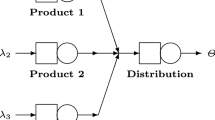Abstract
Overflow queuing models are often analyzed by explicitly solving a large sparse singular linear systems arising from Kolmogorov balance equations. The system is often converted into an eigenvalue problem the dominant eigenvector of which is the desired null vector. In this paper, we convert an overflow queuing problem into an eigen-value problem of size 1/2 of the original. Then we devise an orthogonal projector that enhances its convergence by removing unwanted eigen-components effectively. Numerical result with some suggestion is given at the end.
Similar content being viewed by others
References
G. P. Barker and R. J. Plemmons,Convergent iterations for computing stationary distributions of Markov chains, SIAM J. Alg. Disc. Meth., 7 (1986), 390–398.
G. P. Barker and S.-J. Yang,Semi-iterative and iterative methods for singular M-matrices, SIAM J. Matrix Anal. Appl., 9 (1988), 168–180.
A. Berman and R. J. Plemmons,Nonnegative matrices in the mathematical sciences, Academic Press, New York, 1979.
J. E. Dennis, Jr. and R. B. Schnabel,Numerical methods for unconstrained optimization and nonlinear equations, Prentice-Hall, New Jersey, 1983.
M. Eiermann, I. Marek, and W. Niethammer,On the solution of singular linear systems of algebraic equations by semiiterative methods, Numer. Math., 53 (1988), 265–283.
G. H. Golub and C. F. van Loan,Matrix computations, 2nd ed., Johns Hopkins Univ. Press, Baltimore, Maryland, 1989.
L. Kaufman,Matrix methods for queuing problems, SIAM J. Sci. Comput., 4 (1983), 525–552.
L. Kaufman, J. B. Seery, and J. A. Morrison,Overflow models for Dimension PBX feature packages, Bell Sys. Tech. J., 60 (1981), 661–676.
J. A. Morrison,Analysis of some overflow problems with queuing, Bell Sys. Tech. J., 59 (1980), 1427–1462.
J. A. Morrison,An overflow system in which queuing takes precedence, Bell Sys. Tech. J., 60 (1981), 1–12.
M. Neumann and R. J. Plemmons,Convergent nonnegative matrices and iterative methods for consistent linear system, Numer. Math., 31 (1978), 265–279.
J. M. Ortega,Numerical analysis: A second course, Academic Press, New York, 1972.
D. J. Rose,Convergent regular splittings for singular M-matrices, SIAM J. Alg. Disc. Meth., 5(1984), 133–144.
E. Seneta,Non-negative matrices and Markov chains, 2nd ed., Springer-Verlag, New York, 1981.




